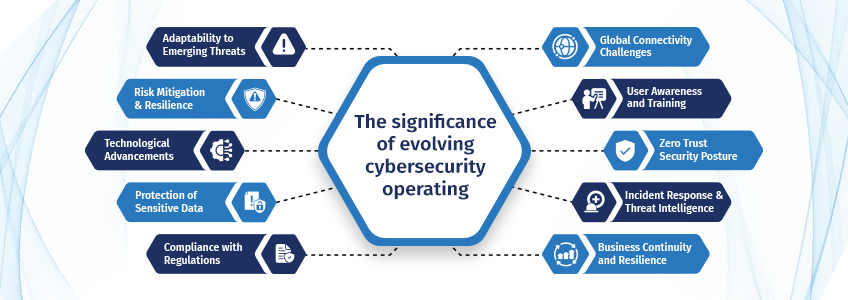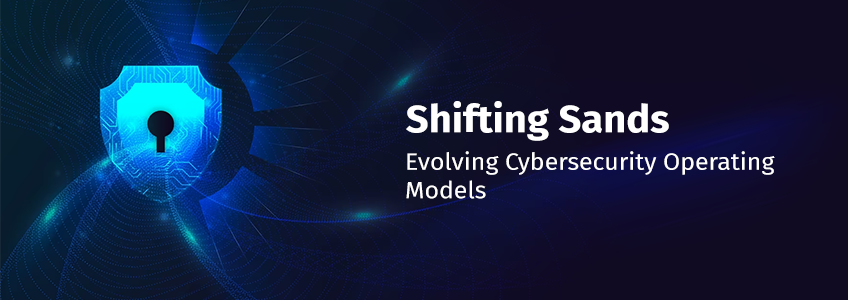Shifting Sands: Evolving Cybersecurity Operating Models
The concept of “Shifting Sands” in the context of cybersecurity encapsulates the dynamic and ever-changing nature of the digital landscape, where security challenges continuously evolve and transform. It draws an analogy to the unpredictable and shifting sands of a desert, where the landscape is in constant flux, requiring adaptability and resilience. In the realm of cybersecurity, this metaphor represents the fluidity and complexity of the threat landscape, necessitating a departure from static and traditional security models towards more agile and responsive operating frameworks.
The “Shifting Sands” metaphor underscores the idea that cybersecurity is not a static, one-time effort but an ongoing process that must adapt to emerging threats, vulnerabilities, and technological advancements. This concept acknowledges that the nature of cyber threats is inherently dynamic, with attackers constantly refining their techniques and exploiting new vulnerabilities. As a result, organizations must navigate through this ever-changing terrain, recognizing that what may have been an effective security measure yesterday might not be sufficient tomorrow.
This dynamic landscape is shaped by various forces, including technological advancements, the expanding attack surface, evolving attacker tactics, and changes in the regulatory environment. Rapid developments in areas such as artificial intelligence, cloud computing, and the Internet of Things (IoT) contribute to the complexity of the cybersecurity landscape, introducing both opportunities and challenges. The “Shifting Sands” concept urges organizations to proactively anticipate and respond to these changes, emphasizing the need for continuous improvement and adaptation in cybersecurity strategies.

In the context of “Shifting Sands,” organizations must move beyond a reactive stance and adopt a proactive and anticipatory approach to cybersecurity. This involves embracing innovative technologies, regularly updating security protocols, and fostering a culture of continuous learning within the organization. It recognizes that traditional security models, often based on static perimeters and rigid access controls, are no longer sufficient in the face of sophisticated and agile cyber threats.
Furthermore, the concept emphasizes the importance of comprehensive risk management. Understanding that the sands are constantly shifting implies that risk is inherent, and organizations must be prepared to identify, assess, and mitigate risks in real-time. This proactive risk management approach involves not only technological solutions but also human factors, including cybersecurity awareness, training, and cultivating a security-conscious organizational culture.
In essence, the concept of “Shifting Sands” challenges organizations to break away from static, complacent cybersecurity practices and embrace a mindset of continuous improvement and adaptability. It acknowledges that the only constant in cybersecurity is change, and organizations that can navigate these shifting sands effectively will be better positioned to protect their assets, data, and systems in the face of evolving cyber threats.
The significance of evolving cybersecurity operating models in the face of dynamic threats cannot be overstated, as the ever-changing nature of the digital landscape requires organizations to adopt agile and adaptive approaches to safeguard their assets and information. The following points highlight the crucial significance of constantly evolving cybersecurity operating models:
- Adaptability to Emerging Threats
Cyber threats continually evolve, with attackers employing increasingly sophisticated techniques. Evolving cybersecurity operating models allow organizations to stay ahead of these threats by adapting their strategies to address new attack vectors, vulnerabilities, and tactics.
- Risk Mitigation and Resilience
A dynamic cybersecurity approach helps organizations identify and mitigate risks effectively. As threats evolve, organizations need to continually reassess their risk landscape and adjust their operating models to enhance resilience against both known and emerging threats.
- Technological Advancements
Rapid technological advancements, such as artificial intelligence, cloud computing, and the Internet of Things, introduce new dimensions to the cybersecurity landscape. Evolving operating models enable organizations to integrate these technologies strategically and securely, leveraging their benefits while mitigating associated risks.
- Protection of Sensitive Data
As data becomes increasingly valuable and targeted, cybersecurity operating models must evolve to ensure the protection of sensitive information. This includes implementing robust encryption, access controls, and data loss prevention measures to safeguard critical assets.
- Compliance with Regulations
Regulatory environments are dynamic, with data protection and privacy laws continually evolving. Adapting cybersecurity operating models is essential for ensuring compliance with changing regulations, preventing legal repercussions, and maintaining trust with customers and stakeholders.
- Global Connectivity Challenges
The interconnected nature of today’s digital world means that threats can emerge from anywhere. Evolving cybersecurity models help organizations navigate the challenges of global connectivity, protecting against cross-border threats and ensuring a consistent security posture across diverse environments.
- User Awareness and Training
Human factors remain a significant source of vulnerabilities. Evolving operating models emphasize continuous user awareness and training programs to educate employees about the latest threats and promote a security-conscious culture within the organization.
- Zero Trust Security Posture
The adoption of a Zero Trust Security model is increasingly crucial in dynamic threat environments. Evolving cybersecurity operating models often involve transitioning from traditional perimeter-based security to a Zero Trust approach, where trust is never assumed, and verification is required from anyone trying to access resources.
- Incident Response and Threat Intelligence
A dynamic cybersecurity approach integrates robust incident response plans and leverages threat intelligence. Rapid response to incidents and the ability to learn from threat intelligence sources are critical components of evolving operating models.
- Business Continuity and Resilience
Cybersecurity operating models that evolve to address dynamic threats contribute to the overall resilience of an organization. This includes strategies for business continuity, disaster recovery, and incident recovery to minimize the impact of cyber incidents on business operations.
In conclusion, the significance of evolving cybersecurity operating models lies in their ability to proactively address the ever-changing threat landscape. By embracing adaptability, organizations can enhance their cybersecurity posture, better protect their assets, and effectively respond to the challenges posed by dynamic and evolving cyber threats.

